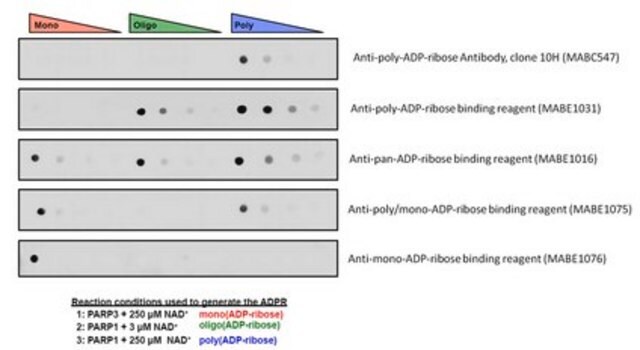MABE1031
Anti-poly-ADP-ribose binding reagent
Anti-poly-ADP-ribose binding reagent is a reagent that selectively binds to ADP ribose for use in Western Blotting, Immunocytochemistry and Dot Blot.
Synonim(y):
poly-ADP-ribose binding reagent
About This Item
Polecane produkty
pochodzenie biologiczne
Escherichia coli
Poziom jakości
forma przeciwciała
purified antibody
rodzaj przeciwciała
primary antibodies
reaktywność gatunkowa
human, mouse
reaktywność gatunkowa (przewidywana na podstawie homologii)
all
metody
dot blot: suitable
immunocytochemistry: suitable
western blot: suitable
Warunki transportu
dry ice
docelowa modyfikacja potranslacyjna
unmodified
Opis ogólny
Specyficzność
Zastosowanie
Immunocytochemistry Analysis: A representative lot detected oligo(ADPR) and poly(ADPR)/PAR in 3T3-L1 cells (Lee Kraus, University of Texas Southwestern Medical Center).
Epigenetics & Nuclear Function
General Post-translation Modification
Jakość
Western Blotting Analysis: This reagent detected oligo(ADPR) and poly(ADPR) on ADP-ribosylated PARP1 recombinant protein (Lee Kraus, University of Texas Southwestern Medical Center).
Opis wartości docelowych
Postać fizyczna
Przechowywanie i stabilność
Handling Recommendations: Upon receipt and prior to removing the cap, centrifuge the vial and gently mix the solution. Aliquot into microcentrifuge tubes and store at -80°C. Avoid repeated freeze/thaw cycles, which may damage IgG and affect product performance.
Inne uwagi
Oświadczenie o zrzeczeniu się odpowiedzialności
Nie możesz znaleźć właściwego produktu?
Wypróbuj nasz Narzędzie selektora produktów.
Kod klasy składowania
12 - Non Combustible Liquids
Klasa zagrożenia wodnego (WGK)
WGK 2
Temperatura zapłonu (°F)
Not applicable
Temperatura zapłonu (°C)
Not applicable
Certyfikaty analizy (CoA)
Poszukaj Certyfikaty analizy (CoA), wpisując numer partii/serii produktów. Numery serii i partii można znaleźć na etykiecie produktu po słowach „seria” lub „partia”.
Masz już ten produkt?
Dokumenty związane z niedawno zakupionymi produktami zostały zamieszczone w Bibliotece dokumentów.
Nasz zespół naukowców ma doświadczenie we wszystkich obszarach badań, w tym w naukach przyrodniczych, materiałoznawstwie, syntezie chemicznej, chromatografii, analityce i wielu innych dziedzinach.
Skontaktuj się z zespołem ds. pomocy technicznej